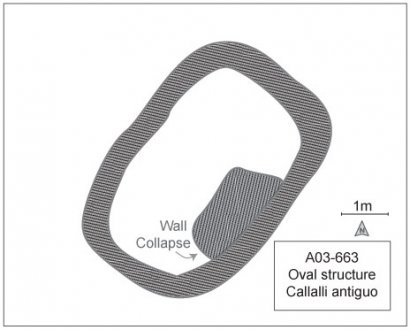Agricultural production
While agriculture is very limited in the modern economy of the Callalli area, evidence of relatively extensive past agriculture is apparent along the Terrace 1 and 2 margins of the Río Llapa. In the vicinity of A03-785 and A03-797 on the east side of Block 3, extensive areas of previously furrowed agricultural lands are evident. Artifact associations with these agricultural lands primarily belong to the Late Intermediate Period and Late Horizon, but the remains of a colonial site near A03-785 is apparent as well.
Structures
On the north side by the road an agricultural sector was encountered with a half-dozen collapsed rock structures including three structures of rounded rectangular form that may have been domestic. These three structures have walls that were constructed using a double coursed design with mortar, and the walls tilt slightly inward. Wernke (2003: 197-199) describes circular houses as being common for pastoral peoples in the higher altitude portions of the Colca valley beginning at the site Laiqa Laiqa near Tuti around 3900 masl. Rounded-rectangular structures are therefore unusual at this altitude in the valley. The double coursed walls of A03-663 measured approximately 90cm in thickness. Other possible explanations for these structures are that they served as storage silos (although the Late Horizon Qolqa storage silos are not found in the Colca valley), or these buildings could have been large burial towers. The ceramics collected in the immediate vicinity of these buildings span the Late Prehispanic with a single local Middle Horizon sherd, several LIP Collagua sherds, and Collagua-Inka LH sherds.
|
Figure 6-83. Base of walls of structure |
Figure 6-84. Collapsed wall of A03-663 structure. |
Ceramics
Surface collections of pottery from the area of Callalli Antiguo reveal that the site is a multicomponent occupation, but that the area appears to have been primarily a Late Horizon settlement. No brushed, unslipped pottery similar to the Chiquero Formative described by Wernke (2003) for the main Colca valley was found in this area.
|
Period |
Style |
Beaker |
Bowl |
Pitcher/Jar |
Plate |
Unknown |
Total |
|
LH |
Chucuito-Inka |
1 |
1 |
||||
|
LH |
Inka |
1 |
2 |
3 |
|||
|
LH |
Collagua-3 |
2 |
2 |
4 |
|||
|
LH |
Collagua-Inka |
1 |
1 |
||||
|
LIP-LH |
Collagua |
1 |
1 |
1 |
3 |
||
|
LIP |
Collagua-2 |
3 |
3 |
||||
|
MH |
Local MH |
1 |
1 |
Table 6-57. Diagnostic ceramics from Callalli Antiguo [A03-662] and vicinity.
The ceramics data suggest that this area, which does not have a pukara adjacent to it, was settled following the Inka conquest in the Late Horizon.
Lithics
A relatively large percentage of obsidian cores were observed at this site, particularly in the southern sector by the houses and chulpasshown on Figure 6-79. It is notable that one half of the fifteen Ob1 cores found in Block 3 were found here, and they are relatively large cores for Block 3.
|
Callalli Antiguo Cores |
Block 3 Surface Collection |
|||||||
|
Material |
No. |
m % Cortex |
mWt |
sWt |
No. |
m % Cortex |
mWt |
sWt |
|
Obsidian |
7 |
10 |
35.9 |
6.82 |
17 |
5.0 |
23.2 |
13.1 |
|
Volcanics |
1 |
20 |
117.8 |
- |
2 |
7.5 |
87.7 |
42.6 |
|
Chalcedony |
1 |
20 |
27.1 |
- |
4 |
16.7 |
47.5 |
18.1 |
|
Chert |
3 |
42.1 |
61.6 |
32.3 |
18 |
32.1 |
57.17 |
33.8 |
|
Total |
12 |
32.1 |
48.4 |
29.0 |
41 |
21.6 |
43.6 |
31.3 |
Figure 6-85. Cores at Callalli Antiguo [A03-662] and vicinity compared with all of Block 3.
It appears that obsidian cores were being transported here from the Maymeja area disproportionately to the rest of Block 3. The other site with a large number of Ob1 obsidian cores (n=6) is Taukamayo [A02-26] that was tested with the A02-26u1 unit and the u2 profile.

